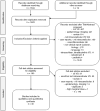Management of sporadic intracanalicular vestibular schwannomas: A critical review and International Stereotactic Radiosurgery Society (ISRS) practice guidelines
- PMID: 38134966
- PMCID: PMC10912008
- DOI: 10.1093/neuonc/noad253
Management of sporadic intracanalicular vestibular schwannomas: A critical review and International Stereotactic Radiosurgery Society (ISRS) practice guidelines
Abstract
Background: The choice of an appropriate strategy for intracanalicular vestibular schwannoma (ICVS) is still debated. We conducted a systematic review and meta-analysis with the aim to compare treatment outcomes amongst management strategies (conservative surveillance (CS), microsurgical resection (MR), or stereotactic radiosurgery (SRS)) aiming to inform guideline recommendations on behalf of the International Stereotactic Radiosurgery Society (ISRS).
Methods: Using PRISMA guidelines, we reviewed manuscripts published between January 1990 and October 2021 referenced in PubMed or Embase. Inclusion criteria were peer-reviewed clinical studies or case series reporting a cohort of ICVS managed with CS, MR, or SRS. Primary outcome measures included tumor control, the need for additional treatment, hearing outcomes, and posttreatment neurological deficits. These were pooled using meta-analytical techniques and compared using meta-regression with random effect.
Results: Forty studies were included (2371 patients). The weighted pooled estimates for tumor control were 96% and 65% in SRS and CS series, respectively (P < .001). Need for further treatment was reported in 1%, 2%, and 25% for SRS, MR, and CS, respectively (P = .001). Hearing preservation was reported in 67%, 68%, and 55% for SRS, MR, and CS, respectively (P = .21). Persistent facial nerve deficit was reported in 0.1% and 10% for SRS and MR series, respectively (P = .01).
Conclusions: SRS is a noninvasive treatment with at least equivalent rates of tumor control and hearing preservation as compared to MR, with the caveat of better facial nerve preservation. As compared to CS, upfront SRS is an effective treatment in achieving tumor control with similar rates of hearing preservation.
Keywords: conservative surveillance; intracanalicular; microsurgical resection; radiosurgery; vestibular schwannoma.
© The Author(s) 2023. Published by Oxford University Press on behalf of the Society for Neuro-Oncology.
Conflict of interest statement
All authors have disclosed their conflicts of interest as follows: A.B. none; A.S. consulting fees from Elekta, Variant Medical Systems & BrainLab, payment for lectures from AstraZeneca, Elekta A.B., Varian, BrainLAB, Seagen, support for the meeting from Elekta, Varian, BrainLAB, society board from International Stereotactic Radiosurgery Society, A.O. Spine Knowledge Forum Tumor and Member to the Elekta M.R. Linac Research Consortium, the Elekta Oligometastases Group and the Elekta Gamma Knife Icon Group; R.K.: consulting fees from Kazia Therapeutics, Elekta A.B., Viewray Inc., Castle Biosciences, NovoCure, payment for lectures from Elekta A.B., Accuray Inc., Novocure Inc., Viewray Inc., Elsevier Inc., BrainLab, Peerview Institute for Medical Education, Ion Beam Applications, Monitoring Board from Viewray Medical Advisory Board, G.T. Medical Technologies Data Safety Monitoring Board, Insightec Ltd, Plus Therapeutics, Inc; L.F. none; A.G. none; M.L. none; L.M. none; I.P.: consulting fees from Elekta Instruments, payment for lectures from Elekta Instruments, Variant Medical Systems & Zap Surgical; B.P. none; J.P.S.: consulting fees from Philps & Novocure, support for meeting from Novocure, board society for Neutron Therapeutics, EmpNia & International Radiosurgery Research Foundation; J.H.S. officer in ISRS; Z.Z. none; S.Y. none, J.R.: president elect of the WSSFN, secretary of the ESSFN.
Figures


References
-
- Stangerup SE, Tos M, Thomsen J, Caye-Thomasen P.. True incidence of vestibular schwannoma? Neurosurgery. 2010;67(5):1335–40; discussion 1340. - PubMed
-
- Dzierzęcki S, Turek G, Czapski B, et al. . Gamma knife surgery in the treatment of intracanalicular vestibular schwannomas. Acta Neurol Scand. 2020;141(5):415–422. - PubMed
-
- Carlson ML, Glasgow AE, Grossardt BR, Habermann EB, Link MJ.. Does where you live influence how your vestibular schwannoma is managed? Examining geographical differences in vestibular schwannoma treatment across the United States. J Neurooncol. 2016;129(2):269–279. - PubMed
-
- Babu R, Sharma R, Bagley JH, et al. . Vestibular schwannomas in the modern era: epidemiology, treatment trends, and disparities in management. J Neurosurg. 2013;119(1):121–130. - PubMed

